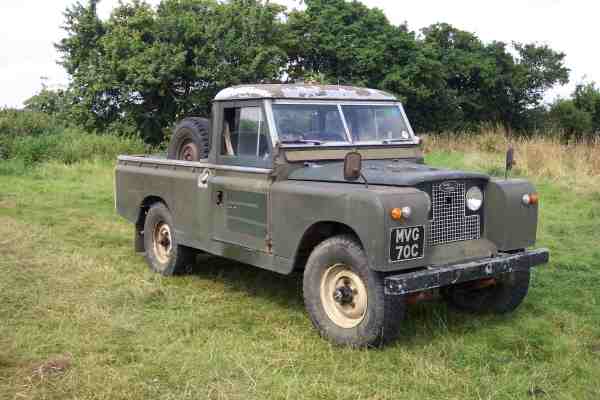![]()

A Land
Rover glossary![]()
![]()
When reading descriptions of Land Rovers for sale, there are many terms which might confuse the first-time buyer. Here is a handy guide to some of the more common words and phrases, and what they mean.
|
A-bar |
Tubular steel front crash protection bar with mounts for spotlights. Currently very fashionable as an aftermarket accessory for Defenders. See photo below.
|
|
Alpine lights |
Narrow oval windows to be found in the outer edges of the roof on Station Wagons. Sometimes fitted as an optional extra to hard top Land Rovers. |
|
Bulkhead |
The structure between the engine bay and vehicle interior, to which the windscreen, front doors, front wings and bonnet are attached. Made of mild steel and can rot badly. Very expensive to replace. |
|
Bull bar |
Large piece of ironmongery bolted to the front bumper for added crash protection. Now rather unfashionable as they are not very pedestrian friendly. Most people fit A-bars instead. |
|
Centre differential |
Found in the transfer box in 90, 110 and Defender models. Allows permanent four wheel drive without excessive tyre wear. Can be locked for off-road use in slippery conditions. |
|
Chequer plate |
Shiny 3mm aluminium sheet with an 'anti-slip' pattern. Intended for use on gangways, ramps etc, but hugely fashionable for giving Land Rovers that tough industrial look. Now available in a huge variety of pre-cut shapes to attach to almost every outer surface of your Land Rover. Handy for covering up minor damage to wings, sills etc., but otherwise purely decorative. |
|
Chrome balls |
See steering swivels |
|
County |
'Luxury' trim specification, found on late Series III and early 90/110. Cloth seats, headlining etc. |
|
Dixon-Bate |
Manufacturer of sturdy adjustable-height tow hitches, very popular with Land Rover users. |
|
Double-declutching |
Driving technique which allows crunch-free gearchanges on gearboxes with no (or badly worn) synchromesh. Essential for Series II/IIA drivers, useful on more modern Land Rovers with worn gearboxes. For an explanation of how to do it, click here. |
|
EP90 |
Heavy duty gear oil, used in the gearbox (Series II/III only), transfer box, axles and steering swivels. The stuff that leaks onto your drive. |
|
Free wheel hubs |
Popular accessory for Series vehicles, disconnects the front wheels from the front differential and driveshaft to reduce drag, noise and vibration when running on-road in 2 wheel drive. |
|
Hard top |
Van type body, usually comes with a safari door, See photo below. Can be fitted with side windows and rear seats.
|
|
Modular wheels |
Popular aftermarket steel wheels, a multihole pattern with a ring of small bolts running round the edge. See photo below.
|
|
Overdrive |
Highly desirable accessory for Series vehicles, effectively adds a fifth gear for relaxed cruising. |
|
Parabolic springs |
A desirable modification for Series vehicles. A Series vehicle fitted with parabolic springs will ride just about as well as a new Defender. |
|
Safari door |
Full depth, side-opening rear door. Standard on all station wagons, optional (although very common) on other Series vehicles, standard on hard top 90/110 and Defenders |
|
Salisbury axle |
A heavy duty rear axle, fitted to long wheelbase Series III and One Ten vehicles. Can be fitted to earlier long wheelbase vehicles, but requires expert welding to adapt for short wheelbase ones. Almost indestructible and therefore highly desirable. |
|
Stage One |
The unofficial name given to an interim model which had most of the features of the Series III, but permanent four wheel drive and a V8 engine, also the flat front design which became standard on the 90/110 and Defender. Click here for more information.
|
|
Station wagon |
The original people carrier. Short wheelbase vehicles seat seven, long wheelbase seat ten or twelve depending on specification. Rear seats are cramped and uncomfortable for adults but brilliant for children. Comes with alpine lights and safari door. |
|
Steering swivels |
To be found at each end of the front axle. They contain the driveshaft joints which run in a bath of EP90. The oil is prevented from leaking out by a rubber seal around a large chrome ball. The chrome becomes pitted and rusty, the seal tears and you get oil leaks. Replacing chrome balls is an involved and expensive job. |
|
Synchromesh |
The system which allows smooth, crunch free gear changes. Taken for granted on modern cars: but Series II and IIA vehicles only had synchromesh on 3rd and 4th gear. The mechanism can wear badly on the newer vehicles, resulting in crunchy gearchanges. These can be avoided by double-declutching. |
|
Timing belt |
Rubber toothed belt found inside all 2.5 litre Land Rover diesel engines. Must be changed according to the manufacturer's service schedule: otherwise it can snap without warning, which will destroy the engine. Belt replacement quite expensive, new engine much more so. |
|
Transfer box |
A two-speed gearbox which sits behind the main gearbox, and transfers the drive to the front and rear wheels. Series vehicles have a selectable four wheel drive system, 90/110 and Defender have permanent four wheel drive with a centre differential. |
|
Truck cab |
This is the short roof, which just covers the front seats, allowing the vehicle to be used as a pickup truck. See photo below.
|
|
Weber carburettor |
Common fitment to petrol Series vehicles, improves fuel consumption slightly but also reduces power. |
Click here for contact details.




